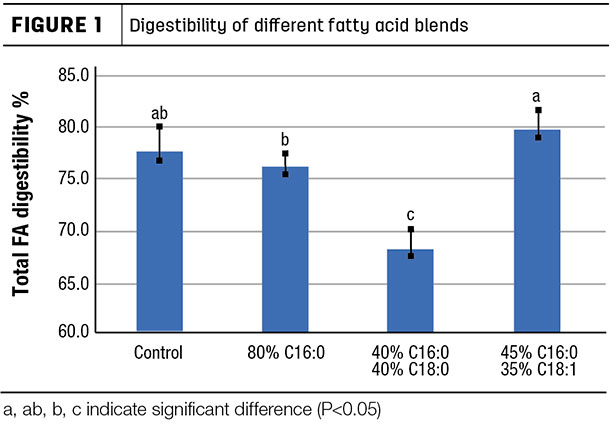Ask dairy producers and nutritionists whether the source of dietary protein makes a difference in performance and the answer is a resounding “Yes!” But the answer may not be as emphatic when you ask about sources of supplemental dietary fat and fatty acids, even though the response should be the same. The source of dietary fat makes a difference in animal performance, just as it does for protein sources. It’s a question of digestibility, bioavailability and more.
In fact, there are distinct differences among fatty acid digestion, metabolism and impacts on milk production, reproduction and health – differences we are learning more about as researchers continue to dissect the complexities of fatty acid nutrition.
Even 10 years ago, researchers at the University of Florida noted, “The use of fat in dairy diets usually increases the energy density of the ration and improves lactation and reproduction. These effects might be mediated by the fatty acid composition of the fat source.”
Recent research at Michigan State University further underscores the different and specific effects of individual fatty acids, observing, “Just as we recognize that not all protein sources are the same, it is important to remember that not all fatty acids or fatty acid supplements are the same.”
Therefore, given the understandably sharp scrutiny of today’s dairy rations, if you allocate dollars to feed supplemental fat, it’s important to make sure you get what you pay for when you invest in this nutrition tool.
Many options
There’s plenty of consensus that fatty acid supplementation in general has been shown to increase milk yield, milkfat yield and milk production efficiency. But confusion can arise because wide variation has been reported in animal performance for different fatty acid types across different diets and studies.
A good part of this variation is due to the range of fatty acid supplements available, including calcium salts of palm fatty acids, saturated fatty acid prills and C-16:0 products. That’s because each carries a different fatty acid profile, and significant differences in effectiveness occur even within fat supplement classes.
As a result, particle size, formulation and effectiveness vary between sources. Due to these formulation and manufacturing differences, product research for one brand does not represent the efficacy of another brand. For example, research shows that as particle size of calcium salts of fatty acids decreases, surface area increases, causing greater biohydrogenation, meaning that not even all calcium salt products feature the same digestibility or provide the same dietary and performance results.
The key is to know what fatty acids are present in the supplement, particularly the fatty acids’ chain length and degree of unsaturation. The digestibility of the fatty acid supplement, as well as its potential interaction with other dietary factors, is important in determining the value of the supplement.
In short, digestibility appears to be a good indicator of inclusion (or not) of a fatty acid in the diet.
A deeper dive into fatty acids
Since the type of fatty acid added to the diet is extremely important, it’s vital to understand the role each type plays in animal performance to help you gain the optimum return on your investment.
Each fatty acid has a primary function:
- C16:0 (palmitic) – Production (milk and milkfat)
- C18:0 (stearic) – Dry matter intake, milk production
- C18:1 (oleic) – Replenish body reserves
- Essential fatty acids
- C18:2 – Immune function, reproductive performance (embryo development)
- C18:3 – Immune function, reproductive performance (embryo survival)
Armed with this information, it’s important to consider possible effects of fatty acids and how they influence animal performance.
For instance, factor in effects in the rumen, via biohydrogenation, milkfat depression and neutral detergent fiber digestibility. Or in the small intestine by affecting dry matter intake (DMI) and digestibility, and in the mammary gland through increased incorporation/substitution. Also consider fatty acid effects on energy partitioning between tissues.
A series of research trials show the following results:
- C18:0 increased DMI, but had no effect on yields of milk or milk components.
- C16:0 increased energy-corrected milk (ECM) and did not affect DMI in both fresh and peak periods.
- C16:0 supplementation induced greater bodyweight (BW) loss and increased markers of lipolysis when fed in the fresh period.
- Fat supplements with more C18:1 increased ECM and BW change.
These results indicate that you may choose a combination of fatty acid sources in rations to optimize their positive effects on your herd. For instance, a diet that contains both C16:0 and C18:1 may help you obtain desirable results from your fatty acid supplement investment, based on your situation and herd goals.
A recent trial investigated the effect of three commercially available blends of supplemental fatty acids on fatty acid digestibility in the total diet. The three blends were compared to a diet of equivalent energy that was not supplemented with fat (control).
To achieve the fatty acid mixtures in the supplemental fats, the researchers compared C16:0 (palmitic acid), a combination of C16:0 and C18:0 (stearic acid), and a combination of C16:0 and C18:1 (oleic acid). As Figure 1 shows, the combination of C16:0 and C18:0 reduced digestibility of total fatty acids. However, when C18:1 was added to C16:0, digestibility significantly improved.

While the addition of a single fatty acid like palmitic acid (C16:0) has decided benefits over supplementing stearic acid (C18:0), the fatty acid profile that includes palmitic acid (C16:0) and oleic acid (C18:1) appears to be a winning combination to improve available energy.
Final considerations
In summary, rely on these factors as you evaluate fatty acid supplementation:
- Know which fatty acids are in the supplement you are using; understanding chain length and degree of (un)saturation are key.
- Pay close attention to digestibility.
- Depend on peer-reviewed, published research.
- Consider particle size.
- Evaluate short-term versus long-term effects.

References omitted but are available upon request. Click here to email an editor.

-
Joel Pankowski
- Manager, Field Technical Services
- Arm & Hammer Animal Nutrition
- Email Joel Pankowski
PHOTO: When evaluating fatty acid supplementation, know which fatty acids are in the supplement you are using, pay attention to digestibility and consider particle size. Photo by Mike Dixon.
What about EFAs?
Essential fatty acids (EFAs) have also been shown to have an effect on animal performance, especially with regard to immune function and reproduction. While certainly an important part of fatty acid supplementation, they are highly regarded for their ability to positively influence immune function and reproduction. C18:2 (omega-6) and C18:3 (omega-3) perform several significant biological functions, including:
- Influencing normal cellular functions
- Alleviating postpartum negative energy balance
- Aiding in the stimulation or inhibition of other reproductive hormones
- Serving as precursors to eicosanoids and steroid hormones, both of which play key roles in immune and reproductive function






